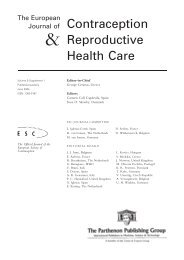Adolescent sexuality and sexual health - Dan Apter - The European ...
Adolescent sexuality and sexual health - Dan Apter - The European ...
Adolescent sexuality and sexual health - Dan Apter - The European ...
You also want an ePaper? Increase the reach of your titles
YUMPU automatically turns print PDFs into web optimized ePapers that Google loves.
WHERE ADOLESCENT<br />
WOMEN LIVE<br />
• <strong>The</strong>re are an estimated 260 million women <strong>and</strong> 280<br />
million men aged 15–19 in developing countries.<br />
• An estimated 70% of these adolescent women live<br />
in Sub-Saharan Africa (45 million), South Central<br />
<strong>and</strong> Southeast Asia (113 million), <strong>and</strong> Latin America<br />
<strong>and</strong> the Caribbean (45 million).<br />
• Variations in patterns of marriage, contraceptive<br />
use <strong>and</strong> levels of unintended pregnancy among<br />
adolescent women are closely linked to their<br />
region <strong>and</strong> the level of poverty in their country<br />
CONTRACEPTIVE ISSUES FOR<br />
ADOLESCENTS<br />
No medical reason currently exists to deny<br />
any method based on young age alone.<br />
No long term endocrine effects<br />
Non-medical issues:<br />
• High risk behaviour, STI<br />
• Lack of accurate information<br />
• Compliance – lack of consistent <strong>and</strong><br />
correct use of methods<br />
Emergency contraception<br />
• Good back-up for condom users<br />
• Available without prescription in many<br />
<strong>European</strong> countries, good experience<br />
• Levonorgestrel can be taken as a single<br />
dose of 1.5 mg WHO, Lancet Dec 2002, 360:1803<br />
• No relevant contraindications<br />
• Both potential problems <strong>and</strong><br />
contraceptive efficacy have been<br />
overestimated<br />
• A tablet can not compensate for lack of<br />
<strong><strong>sexual</strong>ity</strong> education <strong>and</strong> counselling<br />
US vs <strong>European</strong> comparison<br />
• Compared with their Canadian <strong>and</strong> <strong>European</strong><br />
peers, U.S. teens have a similar level of <strong>sexual</strong><br />
activity, but they are more likely to have shorter <strong>and</strong><br />
less consistent <strong>sexual</strong> relationships, <strong>and</strong> are less<br />
likely to use contraceptives, especially the pill or<br />
dual methods.<br />
• Every year, roughly nine million new STIs occur<br />
among teens <strong>and</strong> young adults in the United States.<br />
Compared with rates among teens in Canada <strong>and</strong><br />
Western Europe, rates of gonorrhea <strong>and</strong> chlamydia<br />
among U.S. teens are extremely high.<br />
Guttmacher Institute 2010<br />
Sexual abstinence only programmes<br />
to prevent HIV infection in high<br />
income countries: systemic review<br />
Underhill et al BMJ 2007<br />
• 13 trials enrolling 16 000 US youths identified,<br />
all outcomes were self reported<br />
• No program affected incidence of unprotected<br />
sex, number of partners, condom use, or<br />
<strong>sexual</strong> initiation<br />
Experiences of <strong>sexual</strong> abuse among<br />
girls seeking contraception<br />
• 213 first time visits in 2005, retrospecitve<br />
follow-up of journal until end 2008<br />
• 54 clients, 25%, reported some form of <strong>sexual</strong><br />
abuse when asked about it.<br />
• Mean age 15,9 (13-20) years<br />
• 76 % told about it at the first visit, 17% at 2-3<br />
visit, 4% at 4-5th visit.<br />
• Touching 33%, forced intercourse 25%, verbal<br />
21%<br />
Rinkinen et al, 2012<br />
6








